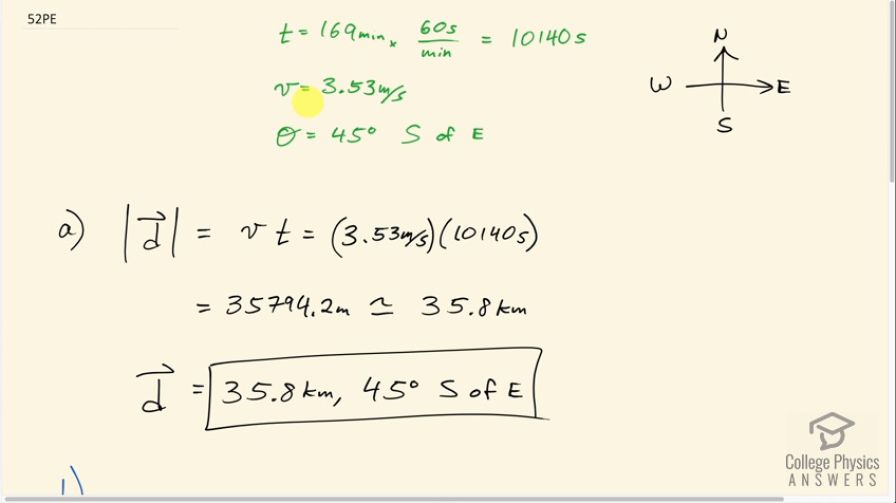Question
Bryan Allen pedaled a human-powered aircraft across the English Channel from the cliffs of Dover to Cap Gris-Nez on June 12, 1979. (a) He flew for 169 min at an average velocity of 3.53 m/s in a direction south of east. What was his total displacement? (b) Allen encountered a headwind averaging 2.00 m/s almost precisely in the opposite direction of his motion relative to the Earth. What was his average velocity relative to the air? (c) What was his total displacement relative to the air mass?
Final Answer
Solution video
OpenStax College Physics for AP® Courses, Chapter 3, Problem 52 (Problems & Exercises)

vote with a rating of
votes with an average rating of
.
Calculator Screenshots
Video Transcript
This is College Physics Answers with Shaun Dychko. Pedal-powered aircraft was traveling for 169 minutes. And we’ll convert that into seconds in order to have our units match with our speed. Which has units of seconds here. So we have multiplied by 60 seconds for every minute. That's 10140 seconds. The speed is 353 meters per second, and the direction is 45 degrees south of east. So this distance that the person traveled is the speed times time; this 3.53 meters per second times 10140 seconds. Which works out to 35.8 kilometers, and that displacement is going to be in the same direction as the velocity. So we say 35.8 kilometers, 45 degrees south of east. In part B, we're told that there’s some wind traveling in the opposite direction to the aircraft with respect to the ground. With a speed of two meters per second. And our job is to figure out what is the speed of the aircraft with respect to the wind. So this is a little mistake there. Okay. Now, when you're adding relative velocities, if you set out the subscripts in a certain way, things will follow a certain recipe. So we want to have the velocity of one thing with respect to the other. So that's a with respect to b. And in this question, it’s the velocity of the airplane with respect to the wind that's important. So capital a is little a and capital b is little w. And we'll add these two velocities together, such that the subscripts are the one that we want listed first with respect to something called x that we don't really care about. In this case that’ll be the ground, plus velocity of something else, which is x/i> with respect to the other thing that we want in our answer. So and this is going to be the velocity of the ground with respect to the wind. And when we do it this way, these inner subscripts so long as they're the same, they will cancel. And we'll be left with the velocity of the first subscript with respect to the second subscript. So, what we want then is the velocity of the air with respect to the wind, in which case we need to have the velocity of air with respect to the ground. Which we have directly given to us by the question. And then add to that the velocity of the ground with respect to the wind. And now that these inner subscripts, little g are the same, they cancel. Leaving us with the velocity of airplane with respect to the wind. And now, we’re not directly given the velocity of the ground with respect to the wind, we're given the velocity of the wind with respect to the ground. But the opposite of that, is going to be of the negative of it. So it’s gonna be the same vector, but just pointing in the opposite direction. This is the velocity of the ground with respect to the wind. And that is the negative of the velocity of the wind with respect to the ground. So that’s two meters per second co-linear with the velocity of the airplane with respect to the ground. So these two vectors can be placed along the same line, head to tail here. Here’s the velocity of the ground with respect to the wind. And we can see that this total then, which is from here to here. This resultant is the velocity of the airplane with respect to the wind and it’s gonna be just adding these two speeds together; So that’s 3.53 meters per second plus two meters per second. Which is 5.53 meters per second. And the displacement of the airplane with respect to the wind is going to be this speed of the airplane with respect to the wind multiplied by time, which is 56.1 kilometers and that is still 45 degrees south of the east.
